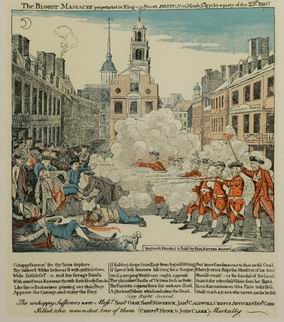

 |
| The Bloody Massacre perpetrated in King Street, Boston on March 5th, 1770 by a party of the 29th Regiment Hand-colored print based on engraving by Paul Revere, silversmith and messenger for the Battle of Lexington and Concord in April 1775. Revere engraved the original depiction of the Boston Massacre within days of the attack, beating fellow engraver Henry Pelham by a few days. An inaccurate portrayal of the actual event, the image was used as propaganda to drive the colonies closer to rebellion. It features the Old State House in the background and portrays British soldiers deliberately attacking a peaceful, unarmed people, massacring them. A sign above the Customs House reads “Butcher’s Hall”. The Boston Massacre, which followed years of unfair taxes and other forms of British tyranny in the minds of many colonists, pushed the American colonies closer to revolution. Paper. L 25, W 19.4 cm |
| Back |